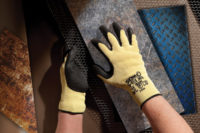As a new decade rolls into our world, will there be any new significant developments in safety, particularly in hand protection that will provide an even safer work environment than the past decade?
The good news is that with the current economic boom that shows no signs of letting up, new jobs and new workers and an increase in infrastructure maintenance and expansion, manufacturing and mining and petrochemical industry expansion, more and more workers need personal protective equipment, especially hand protection. Quite simply put, more jobs equals more safety requirements, more chances for injury and more PPE.
New jobs in the foreseeable future will need the full range of hand protection from mechanical hazards such as cut, impact, flame resistance, puncture resistance, dexterity, protection from hazardous chemicals and physical hazards such as heat and cold protection.
Cut protection
The past decade saw a tremendous increase in hand protection offering cut protection. The standards for measuring cut resistance became more thorough and encompassing when fiber engineering brought cut-resistant materials that were much more protective than before. Previously, ANSI Cut Resistant ratings were classified as ANSI Cut Levels 0 through 5 with level 5 being any material with a weight of > 3500 grams to cut through with a blade travel of 25 mm.
As more cut-resistant glove was engineered and enhanced by adding stainless steel or fiberglass to aramid or polyethylene or cotton, the cut levels got higher than aramid fibers and HPPE had been. The need to further delineate the differences in cut protection offered helped drive the adoption of the more recent ANSI 105-2016 American National Standard for Hand Protection Classification which includes an expanded ANSI Cut Level Rating system. Now there are ANSI Cut Levels of 0 to 9 with the highest ANSI Cut Level 9 being any material that cuts through with a weight of > 6000 grams.
There have always been significant differences in the way cut-resistant gloves are performance rated in America and countries outside the USA. After many years of discussion, a compromise was reached providing the best of both worlds. The TDM-100 or “Tomodynamometer” machine was identified as the cut testing machine by both ANSI and ISO organizations. This is an excellent decision that helps worldwide in the selection of the proper gloves for protecting from one of the most common and serious injuries: lacerations.
Dexterity
All glove manufacturers are continually improving their product offerings and searching for better protection for the industries and workers they are serving. To make a cut-resistant glove normally requires more material thickness to gain a higher cut level. Manufacturers will continually search for thinner gloves that offer more dexterity and bare hand feeling but have higher cut resistance.
Impact protection
Impact protection is needed in many different occupations such as mining, automotive mechanic work or assembly. Many impact injuries to the dorsal or top of the hand can be reduced with the addition of impact pads to the hands. Many new materials -- TPR (thermoplastic rubber), TPU (thermoplastic polyurethane) or silicone -- are and will continue to be used to protect. Many manufacturers will use impact test data from either ANSI 138 or EN 13574 standard test methods to categorize impact protection. The impact protection ratings for ANSI 138 are assigned based upon the amount or percent of impact force absorbed by the impact material. The greater the percentage absorbed, the less impact on the hand. Now that the standard is published with the ratings, manufacturers will search for the best impact materials that absorb the most impact force.
Puncture resistance
There are only a few gloves that offer true puncture protection from a needle or needle-like object. The gloves that do offer needle-stick protection have low dexterity and touch sensitivity. Until a thin-gauge glove that offers protection from needle-stick is developed, engineering controls will continue to be the only solution for many situations.
Flame resistance
Flame-resistant personal protective work clothing has expanded greatly in the past decade. Gloves made from FR materials will grow in the next decade. At the present time, there are FR gloves in the marketplace, but there will most certainly be many more as safety professionals look to provide more protection from a variety of situations that present themselves in occupational safety.
Chemical resistance
Chemical-resistant gloves have not seen many breakthrough products introduced in the past decade. There is still no chemical-resistant glove that resists all chemicals. Hopefully, a new material or combination of materials will emerge that will provide protection from highly hazardous chemicals and especially chemical mixtures.
Multi-hazard environment
The future safety marketplace will see an increase in multi-hazard gloves that protect from more than just one hazard. The reality is that there is never just one hazard. Combining the strengths of protection from mechanical risks, chemical risks and heat and flame resistance will fit many of the new jobs of the future.
At this point in time, the job growth brought about by the current robust economy provides a fertile proving ground for many new products in hand protection. With the higher consciousness of an astute safety culture, the demand for protection from multiple hazards will drive new product development.
A competitive safety marketplace will see many new hand protection options that will certainly be worth evaluating. Keep your employees safe with the latest developments from your trusted hand protection specialists.



